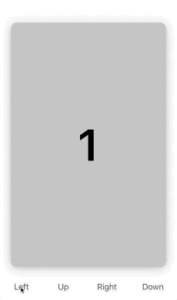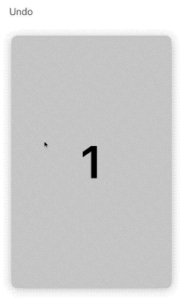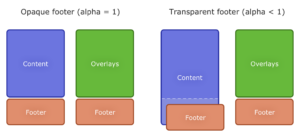- August 28, 2025
- Mins Read

💡 Advanced swipe recognition based on velocity and card position
💡 Manual and programmatic actions
💡 Smooth card overlay view transitions
💡 Fluid and customizable animations
💡 Dynamic card loading using data source pattern
Example
To run the example project, clone the repo and run the ShuffleExample target.
Basic Usage
- Create your own card by either subclassing
SwipeCardor setting its properties directly:
func card(fromImage image: UIImage) -> SwipeCard {
let card = SwipeCard()
card.swipeDirections = [.left, .right]
card.content = UIImageView(image: image)
let leftOverlay = UIView()
leftOverlay.backgroundColor = .green
let rightOverlay = UIView()
rightOverlay.backgroundColor = .red
card.setOverlays([.left: leftOverlay, .right: rightOverlay])
return card
}
The card returned from card(fromImage:) displays an image, can be swiped left or right, and has overlay views for both directions.
2.Initialize your card data and place a SwipeCardStack on your view:
class ViewController: UIViewController {
let cardStack = SwipeCardStack()
let cardImages = [
UIImage(named: “cardImage1”),
UIImage(named: “cardImage2”),
UIImage(named: “cardImage3”)
]
override func viewDidLoad() {
super.viewDidLoad()
view.addSubview(cardStack)
cardStack.frame = view.safeAreaLayoutGuide.layoutFrame
}
}
3.Conform your class to SwipeCardStackDataSource and set your card stack’s dataSource:
func cardStack(_ cardStack: SwipeCardStack, cardForIndexAt index: Int) -> SwipeCard {
return card(fromImage: cardImages[index])
}
func numberOfCards(in cardStack: SwipeCardStack) -> Int {
return cardImages.count
}
cardStack.dataSource = self
4.Conform to SwipeCardStackDelegate to subscribe to any of the following events:
func cardStack(_ cardStack: SwipeCardStack, didSelectCardAt index: Int)
func cardStack(_ cardStack: SwipeCardStack, didSwipeCardAt index: Int, with direction: SwipeDirection)
func cardStack(_ cardStack: SwipeCardStack, didUndoCardAt index: Int, from direction: SwipeDirection)
func didSwipeAllCards(_ cardStack: SwipeCardStack)
-
Note:
didSwipeCardAtanddidSwipeAllCardsare called regardless if a card is swiped programmatically or by the user.
Card Stack Actions
The following methods are available on SwipeCardStack.
Performs a swipe programmatically in the given direction.
func swipe(_ direction: SwipeDirection, animated: Bool)

Shifts the card stack’s cards by the given distance. Any swiped cards are skipped over.
func shift(withDistance distance: Int = 1, animated: Bool)

Returns the most recently swiped card to the top of the card stack.
func undoLastSwipe(animated: Bool)

Card Layout
Each SwipeCard consists of three UI components: its content, footer, and overlay(s).
The content is the card’s primary view. You can include your own card template here.
var content: UIView? { get set }
The footer is an axuilliary view on the bottom of the card. It is laid out above the content in the view hierarchy if the footer is transparent. Otherwise, the footer is drawn just below the content.

var footer: UIView? { get set }
var footerHeight: CGFloat { get set }
An overlay is a view whose alpha value reacts to the user’s dragging. The overlays are laid out above the footer, regardless if the footer is transparent or not.
func overlay(forDirection direction: SwipeDirection) -> UIView?
func setOverlay(_ overlay: UIView?, forDirection direction: SwipeDirection)
func setOverlays(_ overlays: [SwipeDirection: UIView])
Advanced Usage
For more advanced usage, including
visit the document here.
Installation
Shuffle is available through CocoaPods. To install it, simply add the following line to your Podfile:
pod ‘Shuffle-iOS’
The import statement in this case will be
import Shuffle_iOS
Shuffle is available through Carthage. To install it, simply add the following line to your Cartfile:
github “mac-gallagher/Shuffle”
Shuffle is available through Swift PM. To install it, simply add the package as a dependency in Package.swift:
dependencies: [
.package(url: “https://github.com/mac-gallagher/Shuffle.git”, from: “0.1.0”),
]
Download and drop the Sources directory into your project.
Requirements
- iOS 9.0+
- Xcode 10.2+
- Swift 5.0+
GitHub
- August 27, 2025
- SwiftUI
This package provides you with an easy way to show tooltips over any SwiftUI view, since Apple does not provide ...
- August 27, 2025
- SwiftUI
- Uncategorized
SimpleToast is a simple, lightweight, flexible and easy to use library to show toasts / popup notifications inside iOS or ...
- August 27, 2025
- SwiftUI
Create Toast Views with Minimal Effort in SwiftUI Using SSToastMessage. SSToastMessage enables you to effortlessly add toast notifications, alerts, and ...




